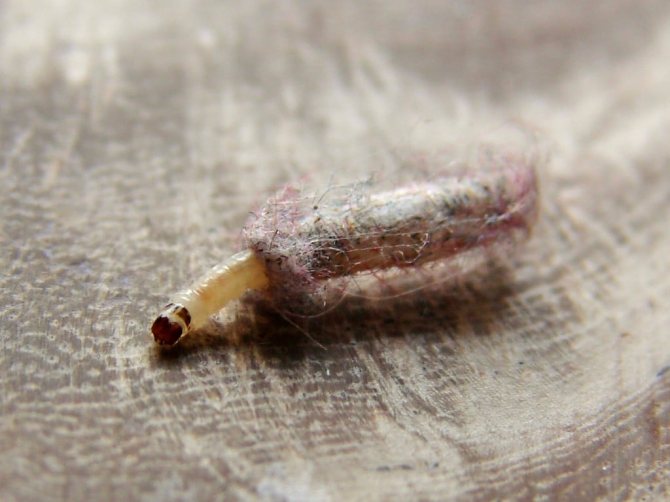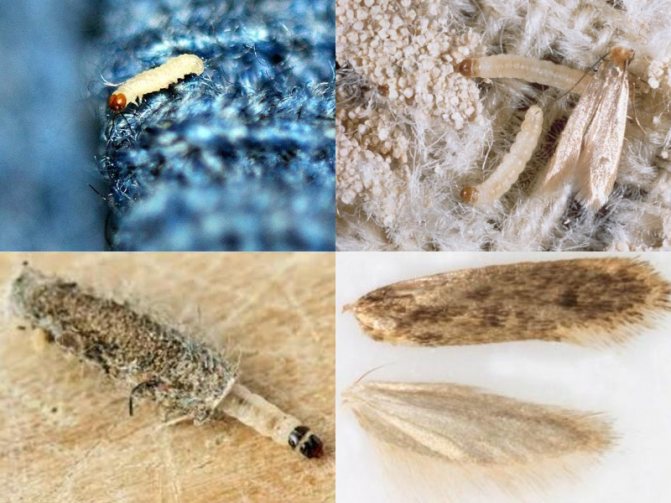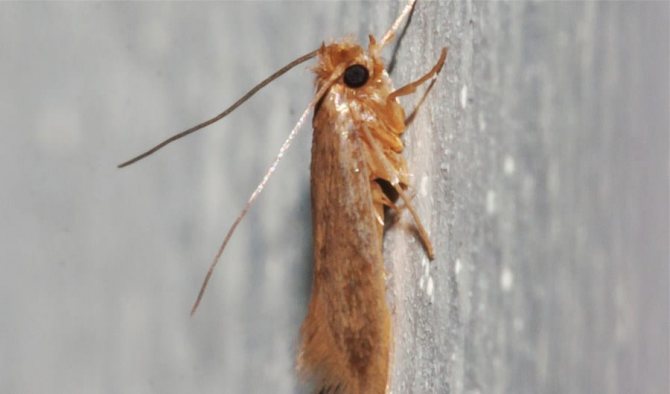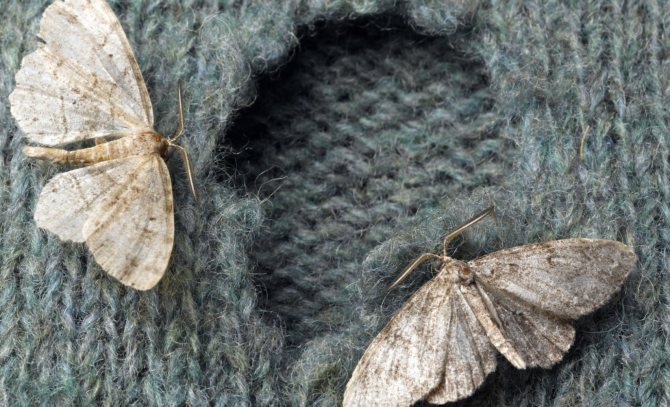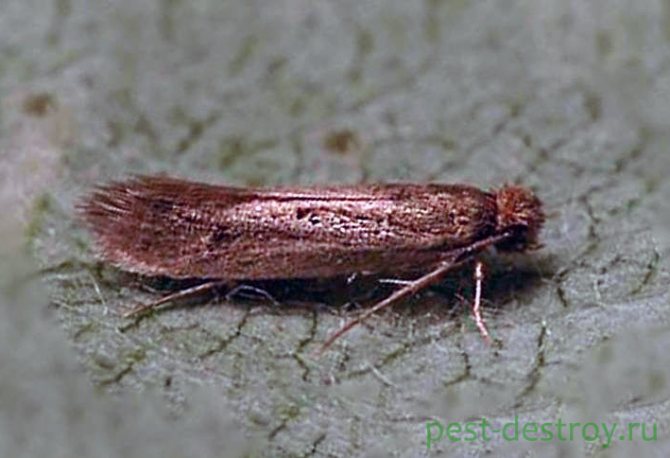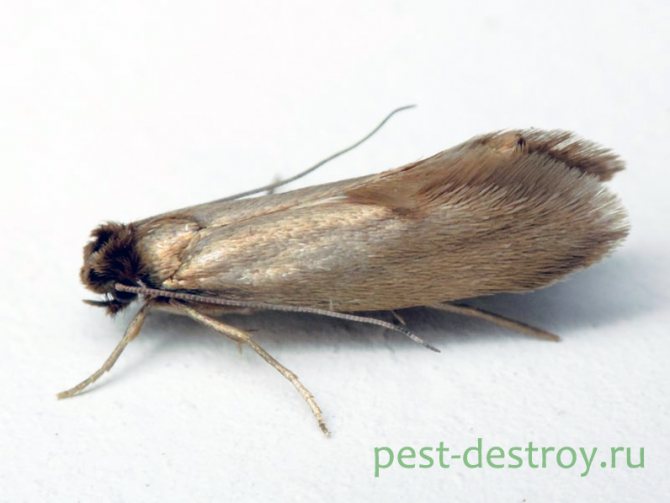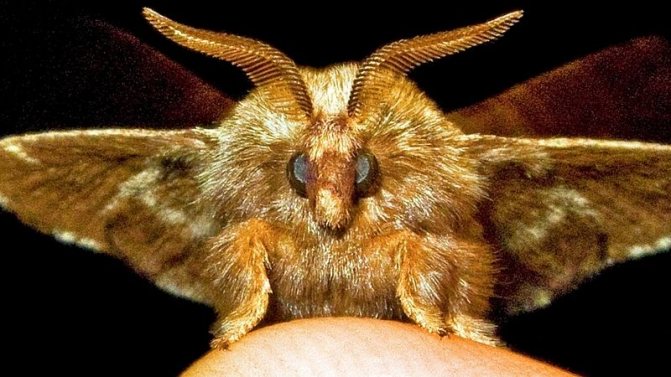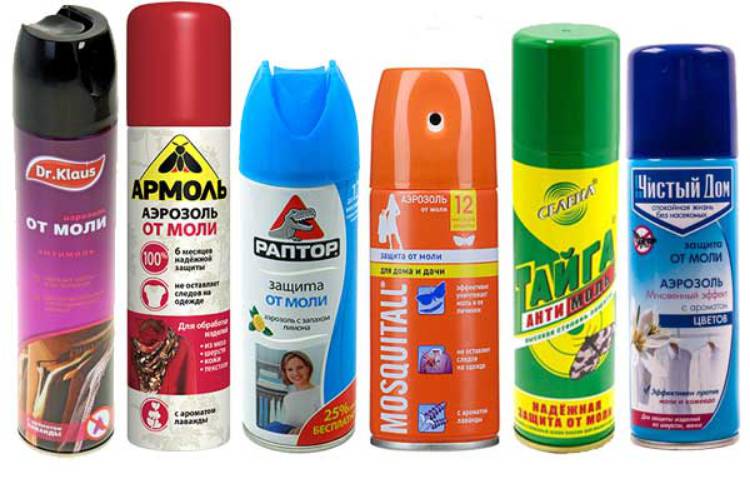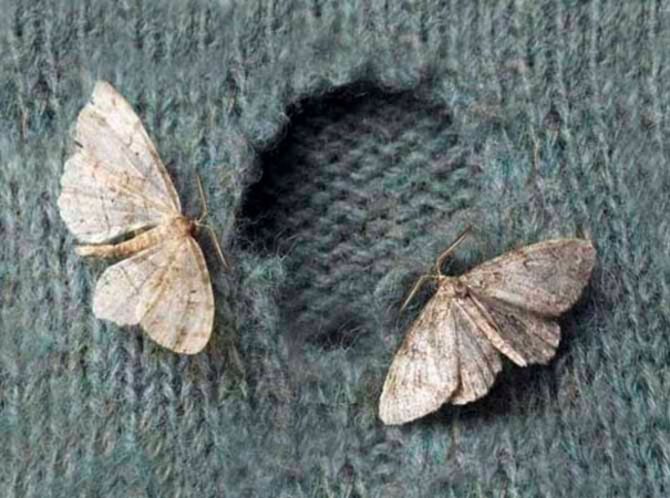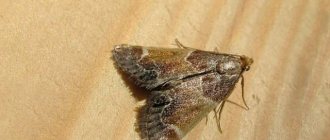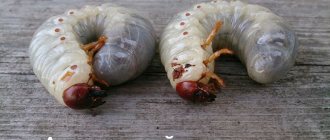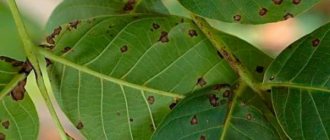Furniture moth is an insect that has been damaging human property for thousands of years - everyone has seen more than one thing spoiled by it. Therefore, the fight against this pest in housing should be carried out constantly.
What you need to know about moths
A moth can be characterized by the following features: It looks like a small brownish yellow, pale gray or white butterfly with a lot of silvery pollen on its wings. This insect goes through the following stages of development: larvae hatch from eggs, then they become butterflies, and adults, in turn, lay eggs. By themselves, moth butterflies are practically harmless. It is worth fearing the larvae that hatch from the eggs laid by butterflies in the fibers of things.
It is important to note that butterflies experience discomfort from sunlight, therefore, they mainly live in dark, hard-to-reach places for sunlight - for example, in closets, wardrobes and dressers. The offspring hatched from eggs, like butterflies, prefers to be in the dark, where it is almost impossible to find the larvae. It should be noted that in the cozy conditions of city houses, the moth is capable of laying eggs all year round!
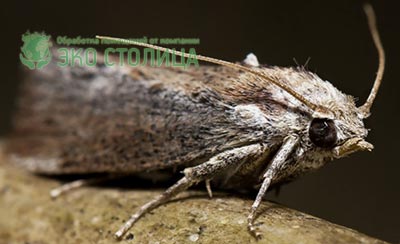
How they develop and reproduce
The development cycle is standard for this class of insects. Adults lay white or silvery microscopic eggs, from which small caterpillars emerge.
This phase of the moth's life is the most dangerous for tissues and dry foods. In the process of growth, the larva requires the maximum amount of food, and the structure of the insect's jaws allows it to process a large amount of material.
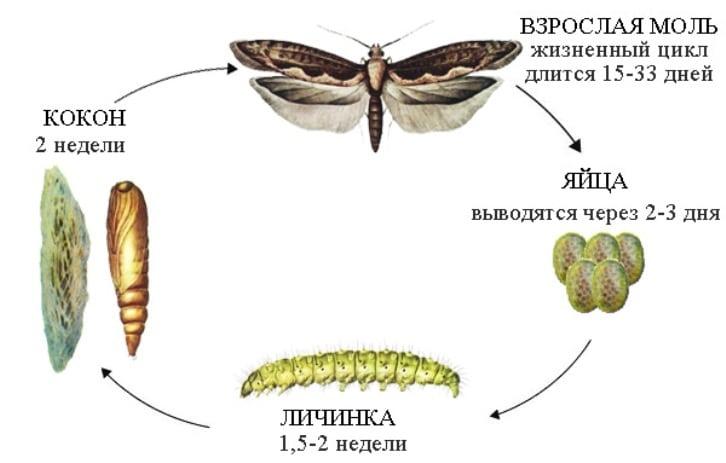

Breeding cycle
After the appearance of moths, their main function will only be reproduction.
Males die immediately after mating. Females end their lives after laying eggs, the number of which can reach several hundred.
Moth lifespan
This is quite an important question, considering that insects are actively eating clothes and furniture.
Before puberty, an individual goes through two stages of development: an egg and a larva. At an air temperature of 20 degrees Celsius, a laid egg develops for two weeks. The larval period of development varies from three to ten months. At this time, the larvae from the nutrient material form a cocoon around themselves, in which they develop in the future.
After acquiring wings, the individual does not live very long - only 2-4 weeks. This period varies depending on the type of parasite. During these weeks, individuals are not particularly mobile and fly mainly in the dark, since the wings are poorly developed, which makes insects very vulnerable.
If you add up the three periods of time during which the life of the moth flows, you get a very impressive period in which the parasites do not waste time in vain, destroying interior items and wardrobe items.
It's easier to prevent - than to destroy
Winter
Owners of expensive furs should carefully study the recommendations on how to keep a mink coat from moths. So, it should be remembered that moisture adversely affects the condition of the fur. If you had to get caught in rain or sleet in a fur coat, then the first thing that is done upon arrival home is drying.Moreover, it should be careful - no hair dryer, gas oven, heater. The correct way is to do it like this:
- the fur coat is shaking;
- hung on a hanger of the appropriate size;
- combed with a special fur brush;
- dries in a calm position.
What are the types of moths
The most common species in the home are:
Fur coat moth


Fur coat moth - an individual with shiny wings of a dark yellow color, dark specks are present on the wings. The lower layer of the wings differs in color from the outer ones: they are light gray. The wingspan is between fourteen and fifteen millimeters. The fur coat moth prefers to eat clothes made from natural materials. The hatching larvae are similar to worms, have a white, almost transparent skin color through which you can see the contents of their stomach, and eight very short abdominal legs. The larvae prefer to consume fur products.
Clothes moth
Clothes moth - surpasses the fur coat moth in size, its wingspan is up to twenty two millimeters. She also has two pairs of wings, which have a purple tint at the very base, passing to the middle in yellow, with a small brown speck at the very top. The larva of the clothes moth is covered with a small white down and outwardly similar to the larva of the fur moth. But, unlike their relatives, clothes moth larvae prefer to huddle in folds or inside woolen fabric, eating large enough spaces of material, invisible from the outside at first glance. The larvae are kept on clothes with the help of a motionless sheath.
Furniture moth
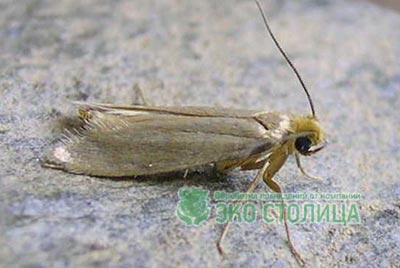

Furniture moth - a representative of this species has shiny silvery-yellow wings, the head is dark yellow, and the base of the wings has a brown tint. This species of keratophages has a significant difference from all other species and thanks to it, it was declared a separate genus. This difference is the absence of mouth tentacles. Furniture moth larvae destroy furniture in a peculiar way: first, the hair stuffing in the soft parts is eaten, then, closer to the pupation period, the larvae appear on the surface of the upholstery and begin to gnaw through tunnels in the furniture cover. Pupation occurs on the lower surface of chairs, armchairs, sofas, beds. In such places, a huge number of light cocoons accumulate. The period of development of larvae depends on the season: in winter it is five months, in summer - about two months. Pupation usually occurs towards the end of winter, that is, in February.
Fighting furniture moths - how to destroy furniture moths at home
Now the fight against this pest at home is effectively carried out using the following methods:
1. Heat treatment - in winter, larvae, eggs, butterflies can be removed by freezing, since the insect dies when the temperature is below zero degrees. Also, the fight at home will be successful when the temperature rises above 35 ° C, that is, in order to destroy the pest, it is enough to warm up the thing outside in the summer. The effectiveness will increase the ultraviolet light, which the larvae cannot stand other forms. The most convenient method is to wash at temperatures above 50 ° C;
2. Mechanical processing - in order to get rid of the larva, it is enough to knock out the thing, since it does not hold well in it. This applies to woolen, cotton clothing, carpet, fur coat type of pest, also will not stay in their shelters. Fighting with the help of this method is not costly, convenient, and it does not matter what the insect looks like, from which the person is going to get rid of;
3. Chemical treatment - fighting with the help of modern aerosols and other means allows you to effectively and safely get rid of the insect;
four.Ultrasonic treatment is the most modern means by which you can get rid of an insect.
Remedies for furniture moths are effective
If the apartment is already severely affected by such a pest, then it will not be possible to do without chemicals, if the homeowner does not use them immediately, then they will continue to eat, damaging things. The most effective in case of severe infection are aerosols Raptor, Reid, and the "Anti-Moth Sections" have also proven their success.
In the early stages, you can use the most economical chemical means: tablets, plates, their term of use is up to six months. Washing at high temperatures (around 50 ° C) is also a successful fight. Many people know what naphthalene looks like, but you need to understand that it only serves to scare away the flying form of an insect, that is, larvae, eggs do not die from its effects. Using almost any folk method, a person will get the same result as from naphthalene - the smells of tansy, other pungent-smelling plants will drive away the flying pest, but the larvae will continue to exist.
When using chemical. means, precautions must be taken, especially when processing takes place in the kitchen.
Agricultural pests
It is better to study the enemy thoroughly so as not to get confused if you suddenly have to meet him not only in the apartment, but also in the garden! It is quite common for entire colonies to attack agricultural crops, poisoning the life of gardeners. Let's consider several main types of moths:
Grain moth
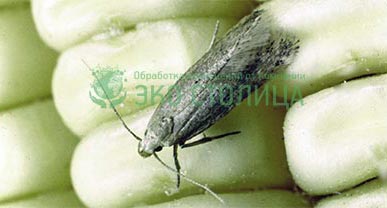

Grain moth - a kind of silvery-white keratophages with a bright brown small pattern on the front wings. They can also be recognized by their gray abdomen and wings, the span of which reaches up to fifteen millimeters. Pupation occurs mainly in the spring and summer. Grain moths are most often found in barns, warehouses, granaries and other places where grain crops are stored. An individual grain moth lays up to hundreds of eggs directly on the grains: one or two eggs are glued to each grain. The female combines several grains into a kind of lump with the help of a secreted sticky liquid, similar to a cobweb, and eats them, being inside this lump of cobwebs. To move, she has to drag the entire bundle with her. This type of moth prefers to pupate in the cracks in the floor and walls. In addition to grains, moths also eat dried fruits and various seeds.
Rye moth


Rye moth - this species has up to thirteen millimeters in wingspan. The hind wings are dark yellow, with a brownish rim. The most common rye moth is found in central Russia. Individuals prefer to lay eggs towards the end of summer on wild cereals and emerging winter crops. The larva eats the core of the stem and spends the whole winter in it. Pupation of rye moth larvae occurs closer to the middle of summer.
Means for removing moths and their properties
Previously used naphthalene is now considered insufficiently effective and harmful to human health.
To scare away insects that accidentally fall into the apartment and to prevent their appearance, folk substances are used, which are almost always on the farm. If the infection does occur, then at the first stage, you can use purchased tools and products.
Materials at hand
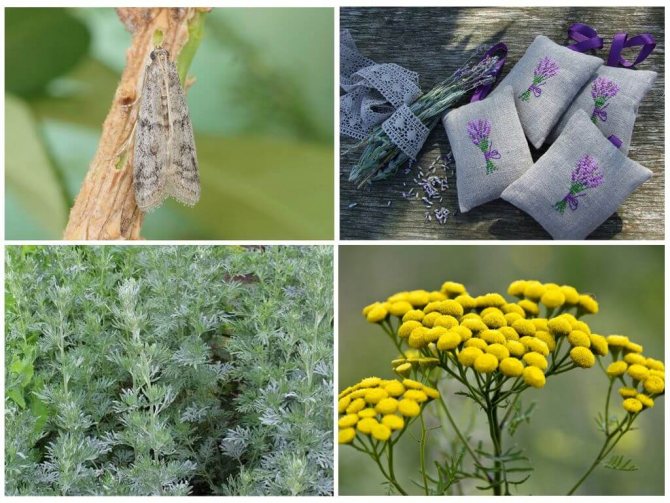

Tansy, lavender and wormwood repel moths with their scent
The basis of their action is the smell, which scares away flying butterflies and does not allow them to settle in the folds of furniture or in places where food and clothes are stored. Usually it is dried herb, which is placed in bunches in closets or in the corners of a room.
Such scarers are:
- tobacco leaves;
- cloves;
- mint;
- lavender;
- odorous soap;
- chestnuts;
- fresh peel of citrus fruits.
To scare away butterflies, it is useful to keep geraniums in rooms or in the kitchen. Its leaves contain ethers, the evaporation of which insects do not tolerate.
Odorless spices placed in food containers - vanilla, allspice, coriander and the same clove - create obstacles to food pests.
Moth traps
Flying individuals can be destroyed using duct tape from flies or special trap houses. The ribbons are hung from the ceiling. The catchers are available with suction cups that allow you to attach them to any surface.
Fumigators


Fumigators will protect the house from moths, but they do not kill larvae
They are connected to the power grid and, when the plate placed inside is heated, evaporates the insecticide in small doses. These fumes are harmless to humans, but deadly to flying moths. But they are not capable of destroying the larvae. It is difficult to fit them inside furniture. To do this, you will have to embed an outlet in the cabinet or stretch an extension cord there.
Fumigators are not fast-acting repellents; the effect of their use appears after a few days.
Anti-milling sections
In terms of their effect and effectiveness, they are between the folk remedy and the fumigator. Inside there are plates with various scents and repellents. But electricity is not required for them, evaporation occurs naturally. Equipped with convenient hooks that allow you to hang them in the closet.
Poisonous aerosols
Spray cans with these substances allow you to spray individual places where moths have started up, as well as to carry out a general treatment of the insides of furniture and the entire room. As a result, butterflies and their larvae are destroyed. Provides complete insect control when used correctly.
They are considered harmless to humans, but it is recommended that the apartment be fully processed with inhalation protection and without unauthorized persons.
Potato moth
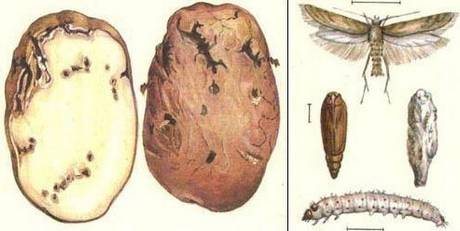

This representative of the parasites does not have the most attractive appearance: the wings are dirty gray in color and dotted with dark spots.
But in the larval stage, the individual is more pleasant in appearance and has a light green (sometimes pinkish) color.
Having winged, the individual acquires a long mustache, and a body length of up to seven millimeters with folded wings. Life in this stage lasts only a few days.
The nondescript appearance appeared for a reason: it helps the pest to remain unnoticed, even if you look at him, as they say, "point-blank".
Females lay eggs on the underside of the leaf surface. The larvae hatched after a while develop very quickly.
As the name implies, potato planting parasites are affected. Individuals can remain alive until the temperature drops to 4 degrees. But individual individuals can climb into the tubers themselves and continue their existence there. Serious cold potato moths wait out, as a rule, in barns, in which there are enough seed potatoes for food. With the same potatoes, the parasites again enter the soil in the spring.
Traditional methods
Strong-smelling herbs such as rosemary, lavender, St. John's wort, wormwood and tansy are suitable for scaring off adults. You can soak cotton wool in tansy oil and arrange the tampons in the closet. You can also put special fragrant sections in the wardrobe, as well as bags of tobacco and citrus peels.
Preventive measures:
- High temperature wash.
- Lack of second-hand items in the closet.
- Dry cleaning of fur products before packing for the summer.
- Thorough washing of sweaty and dirty areas of clothing.
- Keep only clean clothes in the closet.
- Cleaning furniture and carpets with a vacuum cleaner.
- Airing clothes in the fresh air every 3 months, since the moth does not tolerate drafts, heat and cold.
Indoor geranium will become a living scarer.
Cabbage moth
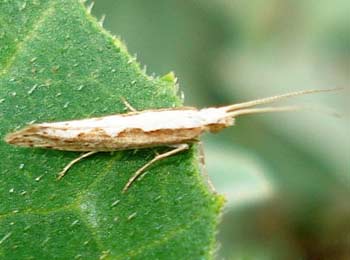

This parasite damages cruciferous crops.Outwardly, it differs from other types of moths: the body is oblong and light green in color, covered with small hairs. You can easily confuse an insect with a straw if it has folded its wings. The wings themselves are framed with fringes along the edges. The larvae have characteristic brown heads.
In terms of activity, cabbage pests are no different from the rest: they are inactive, fly poorly, rarely move far from the place where the cocoon was left. Parasites lead an isolated lifestyle and rarely gather in groups. One, maximum two individuals can be seen on a leaf.
It is not difficult to find and identify the eggs of the parasite: they are elongated and very small. The egg is up to 0.5 millimeters long and only 0.2 millimeters wide. The green color perfectly masks them on foliage.
How to find a mole on a fur coat?
The fur coat moth is a clay-colored insect with a shaggy body. Such a creature does not live long, but in a short time, it manages to postpone a multiple number of larvae. It is these "invisible" larvae that cause widespread harm to your fur coat. There are some signs indicating that pests have settled in the fur product.
It is worth checking the fur coat if:
- Have you noticed a flying moth in the house. Before killing, check the kitchen cabinets, maybe it's a kitchen moth. Then review the fur products.
- New folds and lumps have appeared on your fur coat. She began to look untidy.
- Lint was found at the bottom of the cabinet, like after a hairdressing salon. These are traces from the "haircut" by the larvae of the fur decoration.
- You find "bare" islands or tunnels without hair - this is a red light. It's time to act.
Above is a photo of a fur coat eaten by a moth.
Food moth
It parasitizes inside products, the storage conditions of which have been violated. These are mainly stocks of cereals and groceries in barns. Parasites also find food in the wild: nuts and fruits of crops become prey. For this reason, food pests can often be seen in steppe and forest-steppe areas.
It is curious that this type of moth is not able to harm furniture and clothing, since it can only consume cereals, flour, sugar, dried fruits and berries. Appearance: body length with folded wings - eight millimeters. The discreet color makes the parasite almost invisible.
Caterpillars are pinkish or light yellow in color and have a smooth body. Conditions are considered ideal for development: temperature up to +25 degrees, humidity up to 50%. All life stages of an individual take no more than six weeks.
Why are moth larvae dangerous?
The greatest health hazard is posed by food pests. In a few weeks, they can settle in almost all grocery products and not only digest some of them, but also pollute with waste.
The use of contaminated mixtures can lead to intoxication of the body.
The risk of illness when wearing things after living in them a pay moth without cleaning arises primarily in people with allergies. After using the fabric, the wearer's skin may become irritated.
Chestnut moth
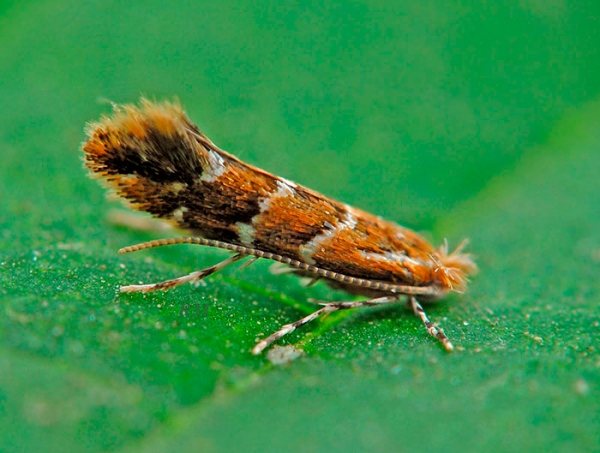

Maple and horse chestnut foliage suffers from it. After spending the whole winter in a pupal state, adult insects appear with the first warmth. Soon the breeding processes begin, which end with the appearance of new offspring in a couple of weeks. Young growth immediately sticks to fresh foliage. This causes early leaf fall and tree death.
The destructive activity of the parasites can be seen on the uneven orange spots on the leaves.
Signs of appearance and harm done
The very first signal to start the fight against clothes or furniture moths will be the appearance of a clumsy moth that absurdly flies in the room from one surface to another. It is much worse to find bald spots on your favorite clothes.The larvae gnaw real holes in sweaters or other outerwear with the addition of natural wool.


In addition to wool and fur, the larvae feed on feathers and silk. On clothes that have been waiting for their time for a whole season, ugly holes may appear. They usually contain cobwebs, lumps of excrement and, of course, the larvae or pupae themselves.
Unfortunately, the pest can only be detected visually: directly flying insects or the consequences of the life of the larvae.
Difficulty killing moths
The shelves of the hardware stores are full of insect repellent. However, modern pests can very quickly adapt to what they are trying to poison. This complicates the pest control procedure. We have to regularly change drugs. And with all this, the final victory is rare.
In view of this, it is easier to attend to the prevention of the appearance of pests. Preventive measures will differ depending on the type of moth. Recommendations on the algorithm of actions in your situation should be obtained from specialists.
How to get rid of furniture moths at home
It is always easier to get rid of a pest at the initial stages of damage to housing. Therefore, the fight should be carried out from the moment the larva or eggs enter the house, and for this it is not so important what a furniture (room) moth looks like. It is enough to strictly follow the preventive measures, for which any thing that has entered the house that can constitute food for an insect must be steamed, washed at high temperatures. You can also fight by freezing, hanging things outside in hot, sunny weather. With these methods, it is easy to get rid of the insect at any stage of the lesion, except for the epidemic. With a large number of pests in the apartment, the fight at home should be carried out with the help of effective aerosols and other chemicals, since only they will quickly get rid of the larva.
In this way, you need to do with clothes in the off-season, for example, with winter clothes in the summer, etc. With the timely implementation of such preventive measures, this insect simply will not start in the house. For prevention, you can use various plants (tansy, lavender, geranium, others), which are placed in cabinets, bedside tables. Any description indicates that the flying moth simply does not want to be near them, no matter how it looks.
Our users recommend


Prevention and storage rules for fur coats
Before sending a fur beauty to "summer hibernation", you need to carefully prepare. This will prevent the appearance of pests.
For this, it is recommended to carry out the following activities:
- Be sure to clean the product after the season is over. Existing traces of wear are removed by dry cleaning.
- Troubleshoot any hardware problems. Redecorate if needed.
- Take care of a protective anti-mole cover that will keep the parasites on the way to the treat. Don't skimp on such an accessory. You can buy covers soaked in essential oils, which moths really hate.
- To prevent pests from touching the fur product, create favorable storage conditions, ventilate the product from time to time, let it breathe.

